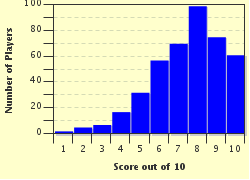Quiz Answer Key and Fun Facts
1. Which of the following wars was ended by the Treaty of Ghent?
2. By signing the Treaty of Nanking in 1842, China ceded which of the following over to Britain?
3. Signed by James IV and Henry VII in 1502, The Treaty of Perpetual Peace attempted to end hostilities between England and which of the following countries?
4. The 1821 Treaty of Cordoba agreed to the independence of Mexico from which European country?
5. Signed in 1494 between Portugal and Spain, the Treaty of Tordesillas divided up which continent between the two countries?
6. The Treaty of Guadalupe Hidalgo ended the Crimean War.
7. The Treaty of Knared brought about the end to the American-Vietnamese War.
8. Which of the following events came about because of the Hay-Bunau-Varilla Treaty in 1903?
9. Signed on June 6, 1835, which of the following is an actual treaty?
10. Which of these treaties formally ended World War I between Germany and the Allied Powers in 1919?
Source: Author
dcpddc478
This quiz was reviewed by FunTrivia editor
bloomsby before going online.
Any errors found in FunTrivia content are routinely corrected through our feedback system.

